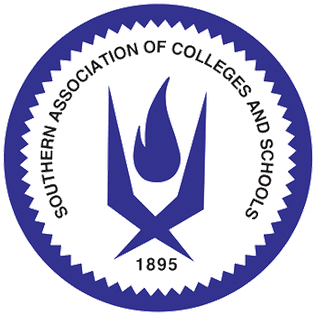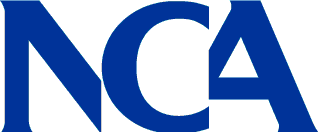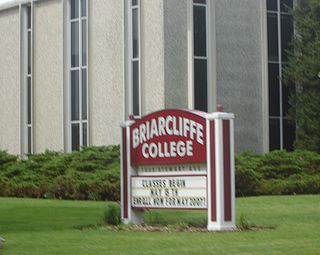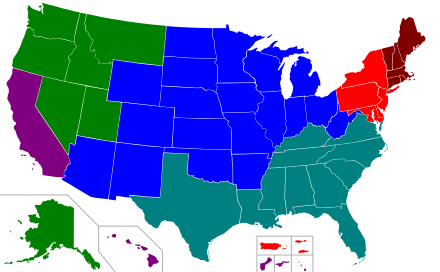
The Western Association of Schools and Colleges (WASC) was an organization that provides accreditation of public and private universities, colleges, secondary and elementary schools in California and Hawaii, the territories of Guam, American Samoa and Northern Marianas Islands, in addition to the Marshall Islands, Federated States of Micronesia, Palau, the Pacific Rim, Peru and East Asia.

The Middle States Association of Colleges and Schools is a voluntary, peer-based, non-profit association that performs peer evaluation and regional accreditation of public and private schools in the Mid-Atlantic United States and certain foreign institutions of American origin. The MSA has until at least 2013 comprised three separate commissions:

The Southern Association of Colleges and Schools (SACS) is one of the six regional accreditation organizations recognized by the United States Department of Education and the Council for Higher Education Accreditation. This agency accredits over 13,000 public and private educational institutions ranging from preschool to college level in the Southern United States. Its headquarters are in North Druid Hills, Georgia, near Decatur and in the Atlanta metropolitan area.

The North Central Association of Colleges and Schools (NCA), also known as the North Central Association, was a membership organization, consisting of colleges, universities, and schools in 19 U.S. states engaged in educational accreditation. It was one of six regional accreditation bodies in the U.S. and its Higher Learning Commission was recognized by the United States Department of Education and the Council for Higher Education Accreditation (CHEA) as a regional accreditor for higher education institutions.

The Northwest Commission on Colleges and Universities (NWCCU) is an independent, non-profit membership organization recognized by the United States Department of Education since 1952 as the regional authority on educational quality and institutional effectiveness of higher education institutions in the seven-state Northwest region of Alaska, Idaho, Montana, Nevada, Oregon, Utah, and Washington. It fulfills its mission by establishing accreditation criteria and evaluation procedures by which institutions are reviewed. The commission is recognized by the Council for Higher Education Accreditation.
California Pacific University or Cal Pacific University was a private business school dedicated to the instruction in all aspects of business at the bachelor's, master's and doctoral levels, and located in Escondido, San Diego County. The university was aimed towards working professionals in business management and was recognized by the California Department of Education as a higher education degree-granting institution. Its graduates and alumni include professionals in business, government, academia, federal and state employees, law, authors, healthcare, technology, and finance.

The Higher Learning Commission (HLC) is a regional accreditor in the United States. It accredits post-secondary education institutions in the central United States: Arizona, Arkansas, Colorado, Illinois, Indiana, Iowa, Kansas, Michigan, Minnesota, Missouri, Nebraska, New Mexico, North Dakota, Ohio, Oklahoma, South Dakota, West Virginia, Wisconsin, and Wyoming. The headquarters of the organization is in Chicago, Illinois.
The Council for Higher Education Accreditation (CHEA) is a United States organization of degree-granting colleges and universities. It identifies its purpose as providing national advocacy for self-regulation of academic quality through accreditation in order to certify the quality of higher education accrediting organizations, including regional, faith-based, private, career, and programmatic accrediting organizations.
The Distance Education Accrediting Commission (DEAC), formerly known as the National Home Study Council and then as the Distance Education and Training Council, is a non-profit national educational accreditation agency in the United States specializing in the accreditation of distance education programs of study and institutions.
The California Bureau for Private Postsecondary and Vocational Education (BPPVE) was a unit of the California Department of Consumer Affairs whose purpose was to protect students by establishing academic standards for of private institutions of higher education in California. BPPVE approval or exemption was required by the State of California to ensure consumer safety from fraudulent or substandard education providers. The agency ceased operation on July 1, 2007, when the legislative authority for its creation expired. A new agency, the California Bureau for Private Postsecondary Education, took its place on January 1, 2010.

Briarcliffe College was a for-profit postsecondary higher education career school with two campuses located in Long Island, New York. The school was owned by Career Education Corporation. The Bethpage campus served Nassau County, New York, and the Patchogue campus was located in Suffolk County, New York. The College offered Associate or Bachelor programs in a variety of areas including Healthcare, Graphic Design, Criminal Justice, Business and Technology. Briarcliffe also offers online classes and programs. The college stopped accepting new students in 2015 and closed in 2018, citing financial difficulties, following a $10.25 million settlement with the New York state attorney general's office over inflated job placement rates in 2013.
National Academy of Higher Education (NAHE) identifies itself as an organization specializing in evaluation of people's educational credentials. Some United States educational authorities identify it as an unrecognized accreditation organization or accreditation mill. NAHE charges fees for a service described as an evaluation of the educational credentials of clients who have studied in other countries or attained degrees through alternative methods.
Proprietary colleges are for-profit colleges and universities. They are operated by their owners or investors, rather than a not-for-profit institution, religious organization, or government. Because they are not funded by tax money, their long-term sustainability is dependent on the value they provide relative to the perceived value of a degree from a higher educational institution overall. The increased reliance on federal student aid funds by these "for-profit" schools is of growing concern. Since federal student loans are typically guaranteed by the government, for-profit colleges can reap a profit from taxpayers even if students drop out after enrolling, do not complete a degree, or the degree turns out to be nearly worthless for future employment. Students can be stuck with large and unmanageable debt loads, defaulting at a significantly higher rate than students at traditional non-profit institutions. Non-profit institutions generally depend in part on academic excellence and creating graduates that succeed in their fields, while for-profit schools are often based on attracting large numbers of students with few requirements in terms of academic qualifications for entry because federal loans are provided for good and bad students alike. Some institutions in this category are regionally accredited, while many others are not. Sometimes a proprietary college may also overlap with the sector of non-degree granting business colleges.

The Middle States Commission on Higher Education is a voluntary, peer-based, non-profit association that performs peer evaluation and accreditation of public and private universities and colleges in selected regions of the United States and foreign institutions of American origin. It is one of the seven regional accreditation organizations dating back 125 years and is recognized by the United States Department of Education and the Council for Higher Education Accreditation.
Higher education accreditation in the United States is a peer review process coordinated by accreditation commissions and member institutions. It was first undertaken in the late 19th century by cooperating educational institutions, on a regional basis.
Educational accreditation is a quality assurance process under which services and operations of educational institutions or programs are evaluated and verified by an external body to determine if applicable and recognized standards are met. If standards are met, accredited status is granted by the appropriate agency.
Pre-tertiary-education accreditation is a type of quality assurance process used in the United States under which services and operations of pre-tertiary schools and educational institutions or programs are evaluated by an external body to determine if applicable standards are met.
The Northwest Accreditation Commission (NWAC), formerly named the Northwest Association of Accredited Schools, is a non-governmental organization that provides accreditation to educational institutions in the Northwestern United States. The Commission accredits K–12, elementary, middle, and high schools; those offering distance education; non-degree-granting postsecondary institutions; and special purpose, supplementary education, travel education, and trans-regional schools in seven states in the northwestern United States. Formerly an independent entity based in Boise, Idaho, it is now a division of AdvancED.








